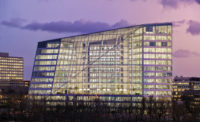Rotterdam
German bombs destroyed the historic center of Rotterdam at the start of World War II, and, ever since, the city has worked to establish a radically new and modern identity. This has led to a sometimes willful emphasis on form-making, but also an openness to experimentation.
As an intermediate kind of public space, the Overblaak was not very successful. But the cube houses, in spite of their difficult floor plans and slanting walls, fared better. They are single-family homes with 975 square feet of space on three floors. At each end of the complex, Blom placed a Superkubus or supercube. The one to the north, on the side of the marketplace, was intended to be commercial space but was never fully used, and its top floor was not even completed. The supercube to the south, on the side of the old harbor, was built to house a school for architects.
Enter Personal Architecture (P-A). In 2009, this young Rotterdam-based firm of Sander van Schaik and Maarten Polkamp refurbished the southern supercube as a Stayokay youth hostel. So when Exodus, a foundation that helps ex-convicts on parole, decided to move to the Blaak Forest, it went to the firm that was already familiar with the vagaries of Blom's design.
Concerned about security, neighbors fought the halfway house project in court, but Exodus prevailed. The supercube on the north, owned by the local housing association and rented to Exodus, now provides 20 rooms for ex-cons (and one for a staff member on night duty) and shared living space for both men and women transitioning from prison.
But before Exodus could move in, the supercube required an extreme makeover. “To make this oddly shaped space of 13,000 square feet suitable for its new use, we had to do a major structural intervention,” says van Schaik. The architects removed the column at the center of the cube, replacing it with an open shaft that serves as an atrium for all four floors. That meant transferring the weight of the upper floors to steel portals at the four corners. Within the atrium, P-A added various functions connected by stairs: reception and pantry on the ground floor, washing and storage spaces on the floors with the residents' rooms, a kitchen on the fourth floor, and a lounge above that. Everything P-A added to the supercube is orthogonal, creating a visual distinction from Blom's overbearing diagonals.
The original stairs—located at two corners of the cube—now serve as emergency exits. On the new stairwell, nets cover openings as a safety measure. To improve acoustics, the architects added felt to the outside of the stairwell on the top and bottom floors, and these surfaces have turned out to be handy bulletin boards as well.
The central atrium is the heart of the renewed supercube, says van Schaik. “It creates not only a physical but also a visual connection between the floors, which is important for people who are learning to live with others again.” Moreover, it brings daylight inside and pulls warm air up, solving two problems that had bedeviled the original building. Warm air is now collected and pumped to a heat-exchange installation. P-A also added new windows—three on the fourth floor to provide views outside and six at the tip for ventilation.
The architect designed the project to encourage interaction among the inhabitants, who spend anywhere between nine and 12 months at the facility. The communal kitchen and dining space on the fourth floor draw people upstairs and are complemented on the other side of the atrium by a living room where residents can relax or work on computers, a smoking area, and a glass-fronted consulting room for private conversations. A cozy lounge sits like a crow's nest above the common spaces, just below the tip of the cube. With a grass-green rug and a television for watching sporting events, it has earned the nickname De Kuip, after the local soccer stadium.
Restoring the residents' sense of individuality was an important goal of the architecture. Small elements—such as painted-wood doorposts, a light in front of each room, large photographs of well-known spots in Rotterdam, and a private shower and toilet in each unit—provide dignity to the living experience. Beds and closets had to be custom-built to be durable and to fit in the unorthodox spaces. Some of the rooms reveal the exigencies of living in an upended cube: a bed in one room cantilevers out from the wall, and its occupant has cut out pieces of paper to cover windows that look directly into the neighboring cube.
Residents in the Exodus program can leave the building during the day but are not allowed to drink alcohol—even off-site—and must take a breath test when they return. The location in the city center helps reinsert them in society, while also providing a supportive retreat. For a facility serving former prisoners in a building with a checkered history, the place has a convivial atmosphere, especially on the communal fourth floor. And bedrooms, small though they are, feel like dwellings rather than cells. Exodus is a halfway house, with the emphasis on “house.” One former convict living there recently even placed a mat in front of his door spelling out in florid letters: home.
People
Client:
Owner:
Architect:
Personnel in architect's firm who should receive special credit:
Interior designer:
Engineers:
Consultant(s):
General contractor:
Subcontractors:
Photographer(s): Ossip van Duivenbode Size: 13,000 square feet Cost: $2,185,000 Completion date: July 2013 |
Products
Structural system
Glazing
Doors
Hardware
Interior finishes
Furnishings
Other furniture:
Lighting
Plumbing
Other unique products that contribute to sustainability: |





















